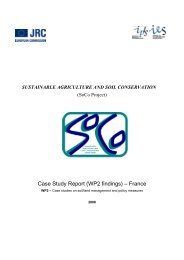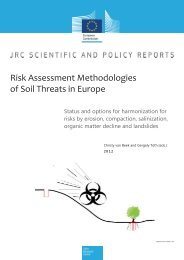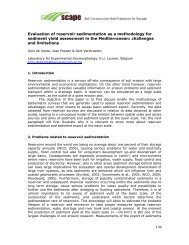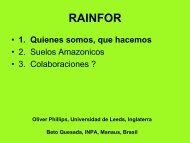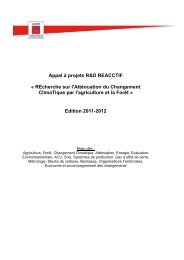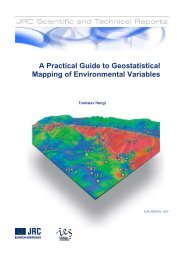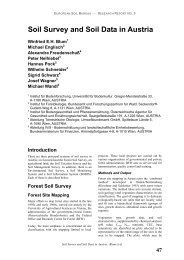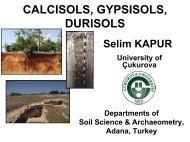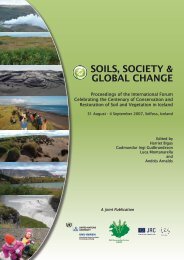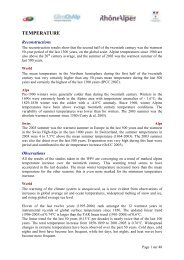Identifying critical limits for soil quality indicators in agro-ecosystems
Identifying critical limits for soil quality indicators in agro-ecosystems
Identifying critical limits for soil quality indicators in agro-ecosystems
Create successful ePaper yourself
Turn your PDF publications into a flip-book with our unique Google optimized e-Paper software.
156 M.A. Arshad, S. Mart<strong>in</strong> / Agriculture, Ecosystems and Environment 88 (2002) 153–160<br />
provide <strong>in</strong><strong>for</strong>mation on the effectiveness of the selected<br />
farm<strong>in</strong>g system, land use practices, technologies<br />
and policies. A farm<strong>in</strong>g system or policies that<br />
contribute negatively to any of the selected <strong><strong>in</strong>dicators</strong><br />
could be considered potentially unsusta<strong>in</strong>able and<br />
thus, discouraged or modified. Systems that improve<br />
per<strong>for</strong>mance of the <strong><strong>in</strong>dicators</strong> can be promoted and<br />
advanced to assure susta<strong>in</strong>ability.<br />
5.1. <strong>Identify<strong>in</strong>g</strong> <strong>critical</strong> <strong>limits</strong><br />
While many papers and reports have been published<br />
<strong>in</strong> the last 5–10 years relat<strong>in</strong>g to the MDS (Arshad and<br />
Coen, 1992; Doran and Park<strong>in</strong>, 1994; Gregorich et al.,<br />
1994; Larson and Pierce, 1994; Karlen et al., 1997;<br />
Mart<strong>in</strong> et al., 1998, Table 2), limited ef<strong>for</strong>t has been<br />
made to determ<strong>in</strong>e threshold values or <strong>critical</strong> <strong>limits</strong><br />
<strong>for</strong> the proposed <strong>soil</strong> <strong><strong>in</strong>dicators</strong>.<br />
What is a <strong>critical</strong> limit? It is the desirable range of<br />
values <strong>for</strong> a selected <strong>soil</strong> <strong>in</strong>dicator that must be ma<strong>in</strong>ta<strong>in</strong>ed<br />
<strong>for</strong> normal function<strong>in</strong>g of the <strong>soil</strong> ecosystem<br />
health. With<strong>in</strong> this <strong>critical</strong> range, the <strong>soil</strong> per<strong>for</strong>ms its<br />
specific functions <strong>in</strong> natural <strong>ecosystems</strong>. For example,<br />
to grow most crops the pH may be 6.5–7.0 or<br />
<strong>soil</strong>-depth may be 50 cm or more.<br />
Selection of <strong>critical</strong> <strong>limits</strong> <strong>for</strong> <strong>soil</strong> <strong>quality</strong> <strong><strong>in</strong>dicators</strong><br />
poses several difficult problems. The ability to supply<br />
Table 2<br />
Key <strong>soil</strong> <strong><strong>in</strong>dicators</strong> <strong>for</strong> <strong>soil</strong> <strong>quality</strong> assessment (after Arshad and Coen, 1992; Doran and Park<strong>in</strong>, 1994; Gregorich et al., 1994; Larson and<br />
Pierce, 1994; Carter et al., 1997; Karlen et al., 1997; Mart<strong>in</strong> et al., 1998)<br />
Selected <strong>in</strong>dicator Rationale <strong>for</strong> selection<br />
moisture, nutrients and physical root<strong>in</strong>g support <strong>in</strong><br />
the absence of toxic substances can be affected by<br />
many physical, chemical and biological parameters.<br />
A detrimental change <strong>in</strong> any of these can reduce the<br />
<strong>quality</strong> of the <strong>soil</strong>, but the quantitative values beyond<br />
which a further reduction <strong>in</strong> these properties is limit<strong>in</strong>g<br />
depend strongly on the crop. For example, a<br />
pH below about 6.5 reduces the yield of alfalfa, but<br />
pH must drop below about 4.0 be<strong>for</strong>e <strong>critical</strong> yield<br />
reduction occur <strong>in</strong> blueberries (Doll, 1964). A <strong>critical</strong><br />
limit of a <strong>soil</strong> <strong>in</strong>dicator can be ameliorated or<br />
exacerbated by <strong>limits</strong> of other <strong>soil</strong> properties and the<br />
<strong>in</strong>teractions among <strong>soil</strong> <strong>quality</strong> <strong><strong>in</strong>dicators</strong> (Table 1).<br />
Given the complexities of yield response to <strong>critical</strong><br />
<strong>soil</strong> parameter values, perhaps, the best we can do is<br />
to develop a set of guidel<strong>in</strong>es that can help set <strong>limits</strong><br />
<strong>for</strong> def<strong>in</strong>ed crop/environment situations. In watershed<br />
analysis, the potential optimum function<strong>in</strong>g of watersheds<br />
can be obta<strong>in</strong>ed from study<strong>in</strong>g the best of the<br />
undisturbed <strong>ecosystems</strong> (Warkent<strong>in</strong>, 1996). A similar<br />
procedure is used when <strong>soil</strong>s that have been under a<br />
certa<strong>in</strong> land management <strong>for</strong> a number of years are<br />
compared with <strong>soil</strong>s that have not been disturbed.<br />
The <strong>in</strong>fluence of climate, especially temperature and<br />
distribution of precipitation, and geomorphology and<br />
weather<strong>in</strong>g rate could be elim<strong>in</strong>ated by compar<strong>in</strong>g<br />
<strong>soil</strong>s only with<strong>in</strong> an ecological region or <strong>soil</strong> type.<br />
Organic matter Def<strong>in</strong>es <strong>soil</strong> fertility and <strong>soil</strong> structure, pesticide and water<br />
retention, and use <strong>in</strong> process models<br />
Top<strong>soil</strong>-depth Estimate root<strong>in</strong>g volume <strong>for</strong> crop production and erosion<br />
Aggregation Soil structure, erosion resistance, crop emergence and early <strong>in</strong>dicator<br />
of <strong>soil</strong> management effect<br />
Texture Retention and transport of water and chemicals, model<strong>in</strong>g use<br />
Bulk density Plant root penetration, porosity, adjust analyses to volumetric basis<br />
Infiltration Runoff, leach<strong>in</strong>g and erosion potential<br />
pH Nutrient availability, pesticide absorption and mobility, process models<br />
Electrical conductivity Def<strong>in</strong>es crop growth, <strong>soil</strong> structure, water <strong>in</strong>filtration; presently<br />
lack<strong>in</strong>g <strong>in</strong> most process models<br />
Suspected pollutants Plant <strong>quality</strong>, and human and animal health<br />
Soil respiration Biological activity, process model<strong>in</strong>g; estimate of biomass activity,<br />
early warn<strong>in</strong>g of management effect on organic matter<br />
Forms of N Availability to crops, leach<strong>in</strong>g potential, m<strong>in</strong>eralization/<br />
immobilization rates, process model<strong>in</strong>g<br />
Extractable N, P and K Capacity to support plant growth, environmental <strong>quality</strong> <strong>in</strong>dicator



